|
Don
Coscarelli will always have a special place in the hearts
of true horror fans for creating Phantasm,
a wonderfully twisted tale of alien invasion, funeral
homes, deadly flying steel balls and large scary men.
That Coscarelli himself flogged the concept to death with
three sequels is neither here nor there (and we liked Phantasm II a lot, as it happens) – he
built the original, he made it run with seductive sweetness,
and he created genre icons in the murderous airborne spheres
and Angus Scrimm's Tall Man. What we've all been waiting for, of course,
is for him to stop making the Phantasm sequels and create an original work that justifies the high regard in which he is held, one that moves him up a step to the exulted position
as one of the Horror Gods. At long last that moment has
arrived, and Coscarelli may step up for generic deification.
Just.
Bubba
Ho-Tep is based on a short story by Joe R. Lansdale and has the
instant hook of a deliciously outrageous set-up. Elvis,
it turns out, did not die of a cardiac arrhythmia after
all. No sir. A while before his supposed demise he became
weary of life at the top and secretly swapped places with
the best of all Elvis impersonators, one Sebastian Haff.
Unfortunately Haff had a weak heart and was even more
addicted to the fast life than The King, rapidly
falling victim to its excesses and leaving the real Elvis
to carry on a contented life as an Elvis
impersonator. That is until he fell off the stage and
broke his hip, an accident that landed in him an East
Texas rest home, where he effectively became a prisoner of his injuries and his new anonymity. Years later he
is bedridden, has a possibly cancerous growth on his penis,
and has his protestations over his true identity ridiculed
by the nursing staff. When he and his closest friend –
a dyed-black John F. Kennedy – discover that the residents
of the home are being killed by a soul-sucking Egyptian
Mummy, they decide that it is up to them to put a stop
to the creature's monstrous feeding habits.
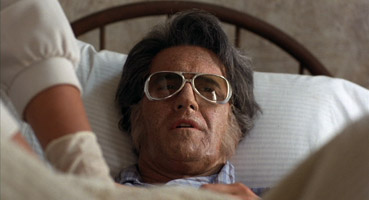
It's
hard to imagine any real genre enthusiast not getting
a litte bit excited by that outline, but before I get to what is great
about the movie I have to address what for me is its principal weakness. The
above may read as an introduction to the story,
but, with the exception of the fine detail and the
inevitable conflict with the Mummy, that's pretty much the whole plot,
and a good deal of that is delivered in economical flashback.
Where Phantasm took a seemingly simple
story and developed it in a complex and intellectually satisfying
fashion (the explanation for what is happening in the funeral
home is a strong revelatory moment), Bubba
Ho-Tep creates an intriguing and inventive situation
and then plays it relatively straight, at least in narrative
terms. Once Elvis and JFK have worked out what is going
on – and the process of doing so is far from complex,
with JFK doing all the necessary research off-screen – it's
just them against the Mummy. There are no unexpected twists,
no clever improvisations on the part of the heroes and,
perhaps most surprisingly, a second use of a straightforward
idea in a short space of time at a moment that cries out for a something new. In essence, Coscarelli has stayed true
to the short story on which the film was based and has
chosen not to substantially expand on it, with the result that the film
feels light on narrative and is stuck with a climax that screams for
some surprise revelation, some moment that
knocks the audience sideways. After presenting us with
so many great ideas in the first two-thirds, the finale
doesn't really justify the extraordinary level of anticipation
the build-up it creates.
However.
HOWEVER.
Yes,
the narrative weakens a little in the final third, and yes,
the climax would benefit from an unexpected and original
twist, but just about every other aspect of the film is an absolute treat. And now that I have my reservations about the
storyline out of the way, I can tell you just why I think Bubba Ho-Tep is one of the most enjoyable
and imaginative American horror films in recent years.
First
up we have the above-mentioned central premise. It has
balls. In the 1970s, one of the key things that made a good many low-budget horror
movies so enjoyable was the imagination and raw energy
of their makers and cast, almost all of whom were doing
it largely out of passion (let's face it, they were getting
paid bugger all, working in impossible conditions on ludicrous
budgets, and had only the slimmest hope that their films
would lead to great things) and their faith in their material. Thus David Cronenberg could propose that
a parasite was transmitting a mind-altering infection
by crawling from person to person through any orifice
it could find; Jeff Leiberman could suggest that a strain
of LSD taken in the 1960s would ten years later cause
its users to go bald and turn into homicidal maniacs;
and Wes Craven could have a family of cannibals living
in a Nevada wasteland prey on unsuspecting holidaymakers
who had strayed from the highway. And we bought it. Every
time. That's the beauty of horror – it can be
outrageous, allegorical and challenging. As long as
you set up and stick to the rules of the world you create, then almost anything is game. The tragedy of modern American horror
movies, which have recently been restricted to limp remakes
of Asian or even earlier US classics, is that they appear to have forgotten this.
Coscarelli brings it back – to a degree at least – and gives
his film a specifically American identity. Sure we have a Mummy
of the old school, but he's a creature
who is as much Texan as he is Egyptian.
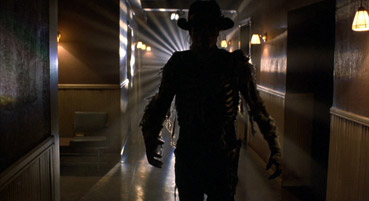
Like
its aforementioned 1970s predecessors, Bubba Ho-Tep was made on a miniscule budget. Exactly how much was actually
spent is uncertain, as precise budgetary information seems
oddly hard to come by, but in the making-of
documentary on this very disc, Coscarelli suggests it was something in the
region of $700,000, an astonishingly low sum for any shot-on-film
movie today. Although this may account for the sometimes
restrictive nature of the action – there are rarely more
than three people on screen at any one time – it forces Coscarelli
to abandon one thing that has, for my money, removed any
sense of fright from modern American horror films: CGI.
So Bubba himself is a guy in a suit and the scarab beetle
that precedes him appears to run on clockwork, but their
simple physicality at a time when actors are generally
required to react to thin air so that an overly designed
monster can be pasted in later is something of a thrill
for us long-term genre fans. And Coscarelli's savvy use
of camera angles and editing still sells both creatures
as genuine threats, especially when Elvis comes under
aerial assault from the beetle with only his bed-pan for
defence.
Second
up we have the characterisation, and here we have to discuss
the casting. As if it wasn't enough to have such a great
premise and the director of Phantasm at the helm, Elvis himself is played by one of modern
horror's few acting icons – Bruce Campbell. Now Campbell
has been the subject of many a debate amongst horror
fans, and sooner or later the conversation
will likely touch on the issue of Campbell's performances – although we love him,
although just seeing him on screen brings joy to our hearts,
although his commentary on the Evil Dead DVD is among the funniest and most informative I've yet heard,
is Campbell really, honestly, that good as an actor? Or
is it just the roles he has landed and the direction he has received
that have pushed some of his performances just a couple of notches
over the top, making him loveable but a bit hard to take that seriously?
For
the record, I have for some time believed that the blame lies at the feet of the roles, the films and their directors. You want
proof? Take a trip back to 1996 and the two-part episode Justice of the groundbreaking police series Homicide:
Life on the Street.
Campbell played Jake Rodzinsky, a detective whose son
is murdered and whose killer escapes justice on a technicality,
and it is one of the most beautifully underplayed
and authentic performances you could hope to see. Campbell himself, in his hugely
enjoyable autobiography If Chins Could Talk – Confessions
of a B Movie Actor, describes this role as one of the most
artistically satisfying experiences of his working life,
and it's not hard to see why. I mention this in part because
if you're a Campbell fan then you owe it to yourself to see
him in that part, but also to counter comments I have
read elsewhere on the Net suggesting that Bubba
Ho-Tep showcases his first really great performance.
It isn't his first. But, by thunder, it is great. For
the most part barely recognisable beneath the old man
make-up, the Elvis wig and the trademark sunglasses, Campbell's
restraint in a role you would almost expect to be played
to the gallery is remarkable. He brings a level of
humanity that enlivens the subtext
(more of that in a minute), makes every movement
and look feel disarmingly real (just watch him struggling
out of bed one night to take a dignified piss instead
of using the bed-pan) and brings a subtle humour to the character that is light years from the crude slapstick
of Army of Darkness. If you can't catch
the Homicide episode, then this will
effectively settle the arguments. Yes, Campbell is not
just a horror legend, he's a bloody fine actor.
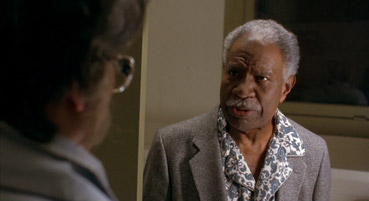
Matching him all the way is the great Ossie Davis as John F. Kennedy. Davis has a dignity, charm
and an instant credibility that engages from
the moment he first appears on screen. Though we are left in no
doubt that Elvis is indeed who he says he is, JFK's true
identity remains more uncertain – despite the racial switch
("they dyed me this colour!"), he displays none
of the ex-president's mannerisms or vocal tics. The suspicion is, with his photos of Oswald and Ruby and his diorama
of Deeley Plaza complete with motorcade and assassin,
that he is what the nursing staff believe is true of Elvis, a man whose
obsession with a famous figure has led him to assume his
identity. It matters not a jot, as the two make for most
engaging and unusual protagonists – in a world where movie
heroes are expected to be young, athletic, fresh-faced
and good-looking, any film in which the leads are two
old guys who have to shuffle to get anywhere makes for
a most refreshing change.
And
then there is the screenplay. One of the key reasons all
of the characters are so
enjoyable, right down to the bit parts, is that they are so smartly written. Individual
character detail aside, the dialogue is sometimes so funny and
so wonderfully devised that just listening to Elvis
pondering on his life or bantering with JFK is a
joy in itself: the musings on what he'd like to do to
his unfortunately located growth; the discussion about
why a Mummy would need to sit on a toilet, let alone write
Egyptian graffiti on the wall; the hilarious banter regarding
JFK's Chocolate Ding-Dong; the apparently improvised moment
when Elvis ends a interview with the hospital administrator
(played by Coscarelli regular and good luck charm Reggie
Bannister) with the line "I've got a boil on my pecker,
what do I care?" – all these and more prompt open
laughter and fond recognition on repeated viewings.
But
not everything is played for laughs. Great horror is almost
always allegorical in some way – the genre just lends
itself to it, something key directors like George Romero, David Cronenberg
and even on occasion John Carpenter (They Live was a direct response to his despair at the Reagan years)
have recognised and used to great effect. One of Bubba
Ho-Tep's most disarming strengths is its very
up-front examination of Elvis's own regret at the things
he has lost and modern society's attitude to the old.
Mocked and neglected by the staff and visitors, mishandled
and insulted even when dead by the funeral directors,
the inmates of the home are left with little dignity,
and the process of battling the Mummy becomes for Elvis
not just a way to regain some purpose and self-respect,
but a stand that must be taken for the elderly in residence. The Mummy is feeding off these people precisely
because it so easily can – if a resident of the home dies
then that's nothing new to the staff as that's what old
people ultimately do. If the circumstances are unusual, then so what?
These people are old and cranky and do strange things.
If they are to be protected, to receive justice, then
who better to dish it out than two of their own, legends
in their own time who are now victims of their own decaying
bodies and the disinterest of the young. With this increasing
sense of purpose Elvis finds a new vitality and a revitalised virility, but it is still to Coscarelli's
real credit that they two remain old men to the end and
do not suddenly discover an elixir or youth
to give them physical powers to match their determination
– Elvis goes into battle against the Mummy not with an
array of guns and super-powers, but a walking frame and
a now-useless array of karate moves.
So
even if Bubba Ho-Tep come up a tad light
on plot, it is nevertheless to be treasured. The first
half is loaded with ideas, the dialogue is a treat, the
character detail just wonderful, and Bruce Campbell turns
in, as David Hunter in The Hollywood Reporter described it, "a performance for the ages."
Genre fans delight – The Independent American Horror Film
is alive and well and living in East Texas.
For
a seriously low-budget film shot on high-speed stock (which
increases the film grain), the film looks rather splendid,
at least in the transfer on offer here. The deliberately
muted colour palette is nicely reproduced, and if the contrast
appears just a little high in places it never harms the
picture in any way. The higher grain of the fast stock used
is rarely visible – the film's moody texture appears just
right here, with solid black levels and generally good shadow
detail.
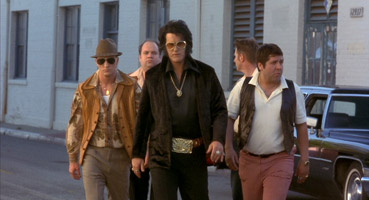
The
5.1 mix is not an aggressive one but is nevertheless
clean and nicely balanced, the main beneficiary being
Brian Tyler's fine music score, though some key effects
are very nicely directed to specific speaks (the biscuit
tin that falls behind you when Elvis is taking a leak, for
example, does a good job of alarming the unwary). Lower
frequencies are minimal – the subwoofer will not be working
overtime here.
Bubba Ho-Tep follows an increasingly
pleasing tradition that sees movies with potential long-term
cult status getting a royal treatment on DVD. Flip to
the Extras screen and you'll be presented with a long
list of options, many of which are substantial goodies,
not the brief textual biographies that some would-be special
editions pass off as key extra features.
First
up we have a Commentary Track
with director Don Coscarelli and star Bruce Campbell.
My mouth was watering even before I listened to a single
word, as Campbell's solo commentary on the Evil
Dead DVD is far and away one of the best around,
being hilariously funny and packed with information about
the film. In partnership with Coscarelli he is a little
more restrained, but notice I say a little – the two men
remain highly enthusiastic about the project and have
plenty of stories regarding the cast, the production
and the short-cuts enforced by working on such a low budget,
always great meat for aspiring film-makers and those with
a fascination for production details. One of my favourites
here involves the extra close-up needed of a the licence
plate in the nearby river, which Coscarelli shot in his
back yard using his daughter's paddling pool. There is,
inevitably, some mutual back-slapping, but it's generally
brief, good natured and, frankly, well deserved.
The
Commentary by The King certainly
sounds like a fun idea, being conducted entirely by Bruce
Campbell as Elvis, but is actually something of a one-joke
affair, with Campbell playing him as if he was the real
deal and has just popped in to take a look at the movie. It
raises a smile or two but never really develops into
anything – Elvis takes calls from associates on his Nokia,
talks about his own movie back-catalogue, disapproves
of the strong language and sexual references and reacts
to what's happening on screen like the sort of audience
thickie I always seem to find myself sat in front of. The only
laugh-out-loud funny moment comes early on, as Elvis bemoans
the fact that people say he didn't take care of his body,
and remarks of an old lady on screen – "We're about
the same age....and I could kick her ass."
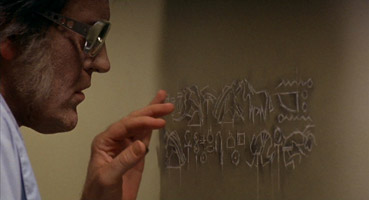
Joe
R. Lansdale Reads From Bubba Ho-Tep has
the author of the original short story reading from its
opening chapter, accompanied by some non-anamorphic 1.85:1
still frame grabs from the film that have been run through
Photoshop's watercolour filter. It's a useful
extra, in part because it puts a voice to the name, but also for
comparison with the finished film. Some
of Elvis's musings have been transferred word-for-word
to the screenplay, but some of Lansdale's more extreme
description has been shied away from, and clearly made
MGM twitch enough to add a disclaimer to the front of
it. It certainly made me want to hunt down the original
text to read the rest of it.
There
are 3 Deleted Scenes, presented
non-anamorphic 1.85:1. The first, Hallway (2:25),
is accompanied by what sounds like Joe R. Lansdale reading
from that scene in the book, which Coscarelli originally
had as part of the film. The second, The Lady's Room,
is just 45 seconds long. Both have optional commentary
by Coscarelli and Campbell. Contrast is a bit heavy on
these, but otherwise they are in pristine shape. Footage
From the Temple Room Floor is the complete
vision of ancient Egypt as experienced by Elvis on his
first encounter with Bubba, but with some clapperboards
left in.
Making
Bubba Ho-Tep
subdivides into four featurettes. The first, The
Making of Bubba Ho-Tep, plays a little like an EPK
in places, but at 24 minutes is a lot more detailed than
that and is a decent look at the conception and making
of the film. There are plenty of interviews with those
involved, though they have been grabbed from a variety
of sources (Campbell, for instance, is interviewed in
two separate locations) and some of them seem to have
been done with an on-camera mic in rooms with horrible
acoustics. There is some useful on-set footage, and it's
worth catching this just to hear the 50-year-old (but
frankly much younger-looking) Ella Joyce talking about
how attractive the 87-year-old Ossie Davis still is. The
picture here is non-anamorphic 16:9. To Make a Mummy
is a 6 minute look at the design and building of Bob Ivy's
Mummy suit and make-up, Fit for a King runs for
8 minutes and takes a look at Elvis's costume design, and
Rock Like an Egyptian is a 12 minute study of
Brian Tyler's scoring of the film, built around an interview
with him conducted by Coscarelli. All three are in the
same style and all of real interest. The first two are
non-anamorphic 16:9, with Rock Like an Egyptian
4:3. All are shot on DV. Photo Gallery consists
of 70+ on-set and preparation-for-shooting photographs
of varying quality occupying sometimes minimal screen
space. There are a couple of goodies in here, but most
are of only moderate interest.
Music
Video is exactly that, a music video of Bryan
Tyler playing the end theme from the film intercut with
shots of the movie itself. As music videos go, this is spectacularly
uninspired. The music's cool enough, though. Once again
this is non-anamorphic 16:9. It runs for nearly 3 minutes.
The Theatrical Trailer is, you've
guessed it, non-anamorphic 16:9, runs for just over 2 minutes
and does a very nice job of selling the film both as a comedy
and a horror piece.The TV Spot is a 30 second version
of the trailer and just as nicely done. It's also 16:9 and
non-anamorphic.
Other
great MGM Releases
features trailers for, good lord, other MGM DVD releases,
though their status as 'great' is questionable in some cases
(Barbershop 2, Jeepers Creepers
1 and 2), though there are trailers
for Osama
and Touching
the Void. I don't think I need to
tell you the screen format.
Bubba
Ho-Tep is a rare delight nowadays, an inventive, original, low-budget
American independent horror film, something to celebrate
when most larger budgeted genre works are third-rate rip-offs
of other movies. As a horror film it's serviceable, but
as study of old age, of regret, of the process of looking
back on our lives to questions the decisions we have made,
it's a joy, and is without doubt one of the most inventive,
original, well-written and played genre films of the year.
At the time of writing the film still hasn't reached UK
cinemas – personally, I wouldn't hang around, as this region
1 DVD has fine picture and sound and a very worthwhile set
of extras, even if one of the most seemingly attractive
falls flat on its face. The King is dead, baby – long live
The King.
|